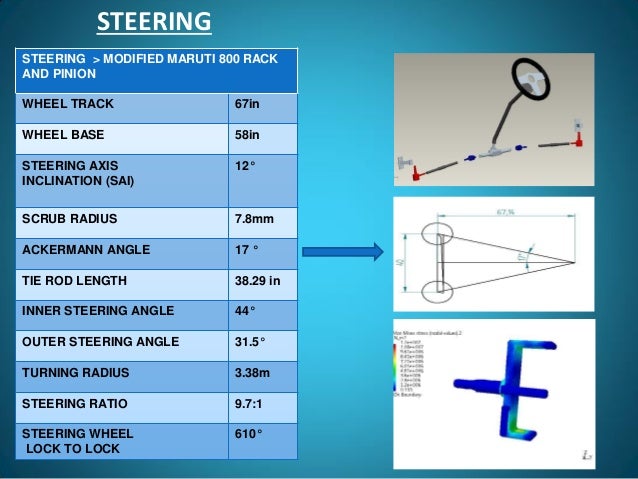
- ACKERMANN STEERING GEOMETRY CALCULATOR HOW TO
- ACKERMANN STEERING GEOMETRY CALCULATOR CODE
- ACKERMANN STEERING GEOMETRY CALCULATOR PLUS
I remember back when implementing PID control was considered something of a dark art on FRC robots, much like inverse kinematics is now.It was an unfortunate situation, but we were able to combat this by increasing the maximum range of motion of the pod rotation to 400°-450° (I don’t remember the exact value off the top of my head), to decrease the number of times the pod would have to pivot 180° and reverse the wheel direction. While translating was rather zippy with a max speed of around 10 ft/sec, complex motion was somewhat sluggish due to slow wheel pod rotation.
ACKERMANN STEERING GEOMETRY CALCULATOR CODE
We derived the same end result for the independent swerve for our 2010 robot, but wrote all the control code in Java.īecause we had to use the ~20W Denso motors for turning the wheel pods, the max omega of the individual wheel pods was rather slow. Nice, simple explanations of the inverse kinematics* of an independent swerve. One approach might be to build some smarts into the control algorithm so that it looks for opportunities to steer the wheels away from the discontinuity whenever doing so would be least disruptive (for example when speeds are very low). The design goal is to minimize the “bad behavior” around the discontinuity. The second “180 problem” I am looking at is more difficult: if the drivetrain does not have unlimited steering, or if the sensors have have gaps (dead zone).

The challenge is to design a tunable (parameterized) algorithm which addresses the shades of gray in between seamlessly.

If, for example, the process variables for a wheel are 10% speed straight forward, and the setpoint variables for that wheel are 10% speed straight backward, perhaps it makes more sense to reverse the wheel’s rotational speed rather than turning it 180 degrees. The initial “180 problem” I hope to address is the case where the steering motors are not sufficiently powerful to provide satisfactory steering response for rapid maneuvers. For the drivetrain stipulated in the paper in Figure 1 (unlimited steering and continuous wheel angle sensor with no gaps) this may well be perfectly adequate - if the steering motors are powerful enough to provide satisfactory response against the given floor material and wheel tread material. The simplest approach is to control each wheel’s speed and angle separately: make each wheel angle go to that wheel’s angle setpoint, and each wheel’s speed go to that wheel’s speed setpoint.
ACKERMANN STEERING GEOMETRY CALCULATOR HOW TO
The “180 problem” is how to control each wheel’s angle and speed, assuming you have correct setpoint variables (speed and angle) and process variables (speed and angle) for that wheel. Each wheel speed computed will be in the range 0…+1. Positive angles are CCW from zero, negative angles are CW from zero. An angle of zero is the straight-ahead direction (relative to the robot). Each wheel angle computed will be in the range -pi to +pi. The algorithms and reference code in the paper properly calculate the correct wheel speed and wheel angle (setpoint variables) for each wheel, for any possible combination of input commands (fwd/rev, strafe, and rotate). I am working on algorithms for the “do I reverse the wheel speed or do I turn the wheel 180 degrees” problem, and will post those here when they’re done. The paper addresses both robot-centric and field-centric commands.

ACKERMANN STEERING GEOMETRY CALCULATOR PLUS
*The first release of the paper presents the solution to the inverse kinematic problem, i.e., given a desired vehicle translational plus rotational motion, what angle and speed should be commanded for each wheel. There is a typo on of document convert_XY_degrees RevE.PDF: The equation should read theta -= 360*floor( 0.5+theta/360)ĭerivation of Inverse Kinematics for Swerve.pdf (48.1 KB)Ĭalculate Swerve Wheel Speeds and Steering angles.pdf (15.3 KB) The wheels can be located anywhere on the robot they don’t have to be at the corners of a rectangle. Inverse Kinematics for swerve with 3 or more wheels. Inverse kinematics Excel spreadsheet with graphical display to test and display swerve wheel speed and steering angle calculations.įorward kinematics calculator implemented in Maxima. UPDATED FILES ARE AT THE BOTTOM, SO SCROLL ALL THE WAY DOWNĭerivation of inverse kinematic equations for three-degree-of-freedom (3 DoF) control for 4-wheel independent steering and independently driven swerve.Ĭonvert Ackermann commands to 3 DoF control.Ĭonvert Cartesian coordinates to 0 to 360 degrees, CW or CCW, from +/- X or Y axis, or from an arbitrary Initial Ray. Thread created automatically to discuss a document in CD-Media.Ĥ wheel independent drive & independent steering (“swerve”)Ĭalculate robot-centric and field-centric wheel speeds and wheel steering angles for a vehicle with four-wheel independent drive and independent steering (“swerve” drive)


 0 kommentar(er)
0 kommentar(er)
